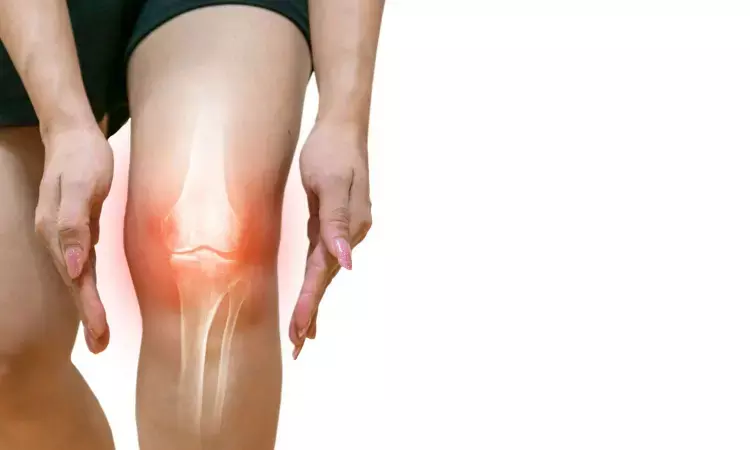- Home
- Medical news & Guidelines
- Anesthesiology
- Cardiology and CTVS
- Critical Care
- Dentistry
- Dermatology
- Diabetes and Endocrinology
- ENT
- Gastroenterology
- Medicine
- Nephrology
- Neurology
- Obstretics-Gynaecology
- Oncology
- Ophthalmology
- Orthopaedics
- Pediatrics-Neonatology
- Psychiatry
- Pulmonology
- Radiology
- Surgery
- Urology
- Laboratory Medicine
- Diet
- Nursing
- Paramedical
- Physiotherapy
- Health news
- Fact Check
- Bone Health Fact Check
- Brain Health Fact Check
- Cancer Related Fact Check
- Child Care Fact Check
- Dental and oral health fact check
- Diabetes and metabolic health fact check
- Diet and Nutrition Fact Check
- Eye and ENT Care Fact Check
- Fitness fact check
- Gut health fact check
- Heart health fact check
- Kidney health fact check
- Medical education fact check
- Men's health fact check
- Respiratory fact check
- Skin and hair care fact check
- Vaccine and Immunization fact check
- Women's health fact check
- AYUSH
- State News
- Andaman and Nicobar Islands
- Andhra Pradesh
- Arunachal Pradesh
- Assam
- Bihar
- Chandigarh
- Chattisgarh
- Dadra and Nagar Haveli
- Daman and Diu
- Delhi
- Goa
- Gujarat
- Haryana
- Himachal Pradesh
- Jammu & Kashmir
- Jharkhand
- Karnataka
- Kerala
- Ladakh
- Lakshadweep
- Madhya Pradesh
- Maharashtra
- Manipur
- Meghalaya
- Mizoram
- Nagaland
- Odisha
- Puducherry
- Punjab
- Rajasthan
- Sikkim
- Tamil Nadu
- Telangana
- Tripura
- Uttar Pradesh
- Uttrakhand
- West Bengal
- Medical Education
- Industry
Calcium Crystal Deposits Linked to Higher Risk of Knee Osteoarthritis, 20-Year Study Finds

Netherlands: Calcium crystal deposition may be a risk factor for knee osteoarthritis (OA), a new research published in Annals of the Rheumatic Diseases has shown.
Researchers from the Department of Epidemiology at Erasmus MC University Medical Center, Rotterdam, led by Yahong Wu, examined whether chondrocalcinosis—a radiographic sign of calcium crystal deposits—can predict the onset of knee OA. Although earlier cross-sectional research has suggested a link between chondrocalcinosis and osteoarthritis, the relationship between these conditions remains uncertain, with questions remaining about whether this calcification is merely a byproduct of joint degeneration or an early contributor to disease development.
To clarify this, the investigators analysed data from two large, long-term cohorts: the Rotterdam Study (RS) and the Multicenter Osteoarthritis Study (MOST). The RS followed 3,737 participants for up to 20 years, while MOST tracked 2,750 participants for seven years. All participants were free of knee OA at baseline, defined as Kellgren and Lawrence grade (KLG) 0 or 1. The team assessed whether the presence of chondrocalcinosis on initial knee radiographs was linked to new cases of radiographic knee OA or the onset of knee pain over time.
The study led to the following findings:
- Baseline chondrocalcinosis was identified as an independent predictor of incident knee osteoarthritis after adjusting for age, sex, and body mass index.
- A meta-analysis of the two cohorts revealed a pooled odds ratio of 1.75 for the development of radiographic knee osteoarthritis in participants with chondrocalcinosis.
- The association remained significant in participants with completely normal baseline knees (Kellgren and Lawrence grade 0), with a pooled odds ratio of 1.77.
- Chondrocalcinosis did not consistently predict the onset of knee pain, indicating that structural joint changes may occur before symptoms appear.
These findings reinforce the concept that chondrocalcinosis is more than an incidental radiographic finding. Calcium crystal deposits could trigger or accelerate cartilage and joint damage, positioning chondrocalcinosis as a potential driver of OA rather than a mere companion to it. According to the authors, this pattern points toward a distinct subgroup of osteoarthritis in which calcium deposition plays a central pathological role.
The results also have implications for clinical practice and future research. Identifying individuals with knee chondrocalcinosis might help clinicians recognize patients at higher risk of developing OA before symptoms appear. Moreover, understanding the mechanisms through which calcium crystals damage cartilage could guide the development of targeted prevention or treatment strategies.
"The study offers robust evidence that radiographic knee chondrocalcinosis significantly raises the likelihood of incident knee osteoarthritis. By highlighting a possible OA subtype linked to calcium crystal deposition, the research opens avenues for further investigation into early interventions and disease-modifying therapies aimed at this specific pathway of joint degeneration," the authors concluded.
Reference:
Wu, Y., Liew, J. W., Boer, J. D., Westerland, M., LaValley, M., Voortman, T., Bierma-Zeinstra, S., Oei, E. H., Van Meurs, J. B., Neogi, T., & Boer, C. G. (2025). Chondrocalcinosis and incident knee osteoarthritis: Findings from 2 large prospective cohorts with 20 years of follow-up. Annals of the Rheumatic Diseases. https://doi.org/10.1016/j.ard.2025.07.009
Dr Kamal Kant Kohli-MBBS, DTCD- a chest specialist with more than 30 years of practice and a flair for writing clinical articles, Dr Kamal Kant Kohli joined Medical Dialogues as a Chief Editor of Medical News. Besides writing articles, as an editor, he proofreads and verifies all the medical content published on Medical Dialogues including those coming from journals, studies,medical conferences,guidelines etc. Email: drkohli@medicaldialogues.in. Contact no. 011-43720751
Next Story


